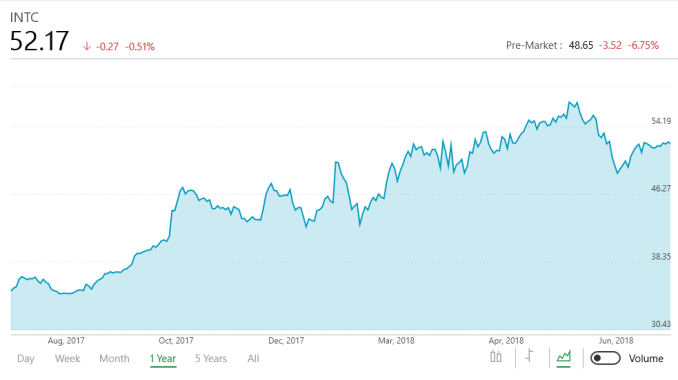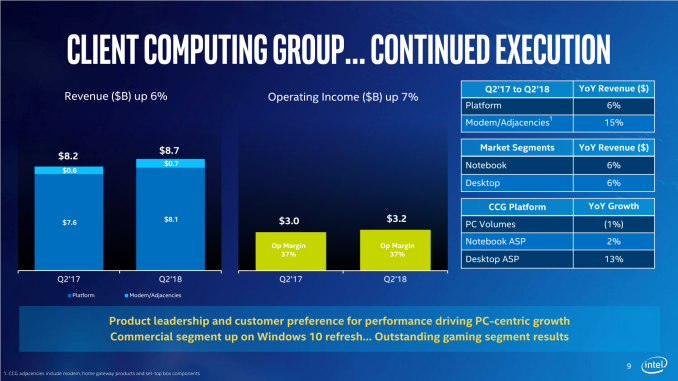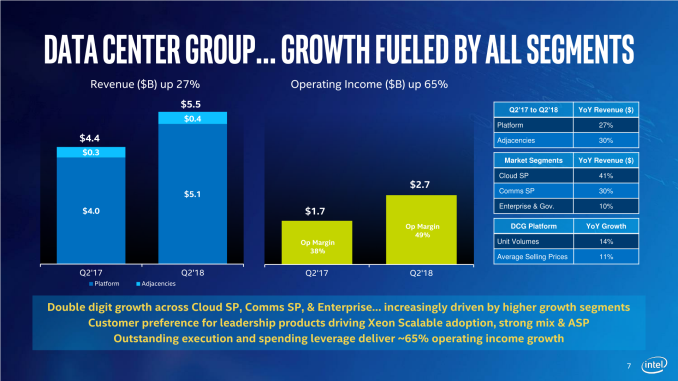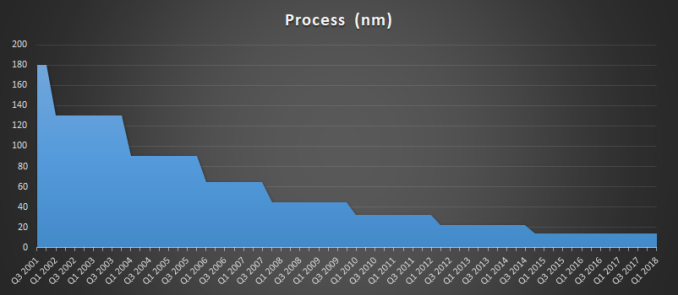Intel Announces Q2 2018 Results: Setting More Records
by Ryan Smith on July 27, 2018 9:00 AM EST- Posted in
- CPUs
- Intel
- Xeon
- Financial Results

All across the hardware industry 2018 is shaping up to be a banner year for earnings, and the 800lb gorilla that is Intel is no exception. Reporting their Q2’2018 earnings yesterday afternoon, Intel booked $17.0B in revenue for the quarter, setting another new Q2 revenue record for the company. Meanwhile net income, while not being noted as a record for the company, was still very high at $5.0B. This puts Intel well ahead of itself both on a year-over-year and sequential basis, topping Q1’2018 and Q2’2017, both of which were also record quarters. All told, Intel’s both Intel’s revenue and net income for the quarter increased by $2.2B year-over-year, while against Q1 they’re up $0.9B and $0.5 respectively.
Meanwhile Intel’s all-important gross margin has held relatively steady at 61.4%, which is down two-tenths from Q2’2017, but up from the previous quarter.
| Intel Q2 2018 Financial Results (GAAP) | |||||
| Q2'2018 | Q1'2018 | Q1'2017 | |||
| Revenue | $17.0B | $16.1B | $14.8B | ||
| Operating Income | $5.3B | $4.5B | $3.8B | ||
| Net Income | $5.0B | $4.5B | $2.8B | ||
| Gross Margin | 61.4% | 60.6% | 61.6% | ||
| Client Computing Group Revenue | $8.7B | -3% | +6% | ||
| Data Center Group Revenue | $5.5B | +6% | +27% | ||
| Internet of Things Revenue | $880M | +5% | +22% | ||
| Non-Volatile Memory Solutions Group | $1.1B | +10% | +23% | ||
| Programmable Solutions Group | $517M | +4% | +18% | ||
Breaking down the numbers by Intel’s various business groups, all of Intel’s groups saw revenue growth for the year. This ranges from 6% for the client computing group, up to 27% for the data center group. And even on a less-comparable quarterly basis, every group except CCG has seen some growth.
Overall Intel has been making a concentrated effort to pivot towards (or at least play up) what the company sees as the segments primed for growth – which Intel is calling its “data-centric” business – and isolate it from the “PC-centric” client computing group. Looking at revenue growth it’s easy to understand why; client computing revenue has been slow to move for years now, while Intel’s other businesses have grown much faster, and as an added kicker are generally more profitable too. None the less, Intel can’t ignore the fact that the client computing group alone makes up more than half of the company’s revenue. However at the rate things are going, this might be one of the last quarters where that is true.
On the client computing front, Intel is citing the commercial and enthusiast segments as being the driving factors for the growth, which is unsurprising as the two have been consistent performers with higher-than-average spending. Beyond that, Intel hasn’t broken down client computing revenue by form factor or such this quarter, so unfortunately we don’t get any insight into how the recently launched Coffee Lake mobile parts have done.
Besides being a more stagnant space, the biggest challenge Intel faces with the client computing group right now is in fact the company’s biggest challenge, which is the stalled development of their 10nm process. As part of today’s earnings call the company has announced that they are still on-track for 10nm mass production in 2019, however they aren’t expecting complete systems to reach store shelves until the holiday shopping season. Which means Intel will be relying on their 14nm technology and resulting products for the next 12 to 15 months, which is going to make it harder to entice already fickle consumers into upgrading.
The news is of course happier with Intel’s other business, all of which have grown at a much greater rate. Intel continues to sell Xeon processors to server vendors and cloud server providers at a good clip, with revenues there improving by 27% year-over-year. And yet even with that growth, Intel actually missed analyst expectations by 2%, indicating just how hot this business segment really is: there’s clearly still very high demand for server processors. Going forward however, Intel is going to be facing off with AMD and EPYC, which is finally finding its footing. So it will take a lot of work to sustain this growth, especially as according to Intel’s own accidentally published roadmaps, the company won’t have 10nm-class Xeons read until 2020, which means Intel will likely be playing defense against AMD starting in 2019.
The rest of the “data-centric” business is a similar upbeat story. FPGA sales are up, non-volatile memory sales are up, and even IoT sales are up. The reasons are varied, but overall NAND prices have been good and the drive for neural networking hardware is helping sales on both the FPGA (cloud) and IoT (edge) sides.
Overall then, based what has now been two strong quarters of growth for Intel, the company is expecting the rest of the year to go similarly. And indeed at this point they’re expecting 2018 as a whole to be their third consecutive record year. Which is especially impressive at a time where Intel’s core manufacturing advantage has increasingly slipped away. Conversely however, there remains the lingering question of whether Intel can sustain this kind of growth for the next year without their next-generation fabrication technology.
Source: Intel Investor Relations



















27 Comments
View All Comments
jcc5169 - Friday, July 27, 2018 - link
Another Intel press releaseHStewart - Friday, July 27, 2018 - link
Same thing AMD when they release there press release - but of course they did not get attackhttp://ir.amd.com/static-files/4853f348-7e3a-49dd-...
FreckledTrout - Sunday, July 29, 2018 - link
You know AMD got nailed hard on wccftech on their earnings. I don't work for either company so I think everyone should nail both of them when its due. Intel is getting crap for delaying 10nm out to 2020 for server chips and rightfully so as its only been since 2016 when they said they would have 10nm chips. I personally love that Intel are leaving the door open for AMD to snag some server market share in 2019 it makes the market way more competitive. I would much rather prefer AMD and Intel had a 50/50 share of the markets they compete in it would drive innovation and pricing.HStewart - Monday, July 30, 2018 - link
You realize that AMD has a serious debt issue - and also there are financial people that believe that AMD stock is overvalue and at same time Intel is stock is undervalue.You also realize that PC CPU is not the only business that Intel is in.
JKflipflop98 - Sunday, July 29, 2018 - link
Yay. More record profits. It was the same thing last year, but the management decided there just wasn't enough money to give the employees raises. Another financial record year. Another year with no raises?amosbatto - Monday, July 30, 2018 - link
Record profits at Intel make no sense, until you go shopping for a laptop or server, and see that almost all of them still have Intel chips. I recently looked at Thinkpad T-series models, and found that they all use Intel chips. Zen might now be a better architecture, but it doesn't mean much when the best laptop brands don't offer it.HStewart - Monday, July 30, 2018 - link
I know there are going to be people that disagree with this - so I will agree to disagree with them.But I found an interesting article about Intel financials.
1. This article author believes that Intel stock is undervalue
2. This article author believes that AMD stock is overvalue
3. Intel lost of CEO of is a major factor in stock changes
https://seekingalpha.com/article/4191921-intels-un...
It also appears that AMD has a lot of DEBT